 In the blog OPEC deal pushes up oil prices John discussed the agreement made by OPEC members to reduce total oil output from the start of 2017, with Saudi Arabia making the biggest cut in output. The amount of oil being provided is a key determinant of the oil price and this agreement to reduce oil output contributed to rising prices. However, now oil prices have begun to fall (see chart below) with Saudi Arabia in particular recording an increase in output but all OPEC nations noting that global crude stocks had risen.
In the blog OPEC deal pushes up oil prices John discussed the agreement made by OPEC members to reduce total oil output from the start of 2017, with Saudi Arabia making the biggest cut in output. The amount of oil being provided is a key determinant of the oil price and this agreement to reduce oil output contributed to rising prices. However, now oil prices have begun to fall (see chart below) with Saudi Arabia in particular recording an increase in output but all OPEC nations noting that global crude stocks had risen.
Supply and demand are key here and over the past few years, it has been a problem of excess supply that has led to low prices. OPEC nations have been aiming to achieve greater stability in global oil markets. Given the excess supply, it has been output of oil that the cartel member have been trying to cut. That was the point of the agreement that came into effect from the start of 2017. However, even with the recent increase in production Saudi Arabia notes that its output is still in line with its output target. The 10 percent fall in crude prices over such a short period of time has led to renewed concerns that pledges to reduce production will not be met. However Saudi Arabia’s energy ministry stated:
“Saudi Arabia assures the market that it is committed and determined to stabilising the global oil market by working closely with all other participating Opec and non-Opec producers.”
There were already concerns about the oil market relating to a potential increase in US shale oil output. Oil producers include OPEC and non-OPEC members and so while the cartel has agreed to cut production, it has little control over production from non-cartel members.  This was one of the main factors that contributed to the oil price lows that we previously saw. OPEC’s forecast for oil production from non-OPEC member has been raised for 2017 and overall production from all oil producing nations looks set to increase for the year, despite OPEC curbing output by 1.2 million barrels per day. However, despite the 10% drop, the price of crude oil ($50) still remains well above its low of $28 in January 2016.
This was one of the main factors that contributed to the oil price lows that we previously saw. OPEC’s forecast for oil production from non-OPEC member has been raised for 2017 and overall production from all oil producing nations looks set to increase for the year, despite OPEC curbing output by 1.2 million barrels per day. However, despite the 10% drop, the price of crude oil ($50) still remains well above its low of $28 in January 2016.
Oil prices are one of the key factors that affect inflation and with UK inflation expected to rise, this fall in oil prices may provide a small and temporary pause in the rise in the rate of inflation. There are many inter-related factors that affect oil prices and it really is a supply and demand market. If US shale oil production continues to rise, then total oil output will rise too and this will push down prices. If OPEC members undertake further production curbs, then this will push supply back down. Then we have demand to consider! Watch this space.
Report
OPEC Monthly Oil Market Report OPEC (14/3/17)
Articles
Saudis stand by commitment to oil production cuts Financial Times, Anjli Raval and David Sheppard (15/3/17)
Oil prices fall after Opec stocks rise BBC News (14/3/17)
Crude oil price slumps to new three-month low after OPEC supply warning Independent, Alex Lawler (14/3/17)
Opinion: Saudi Arabis has a big motivating interest in keeping oil prices high MarketWatch, Thomas H Kee Jr. (14/3/17)
Why oil prices may come under even more pressure next month Investor’s Business Daily, Gillian Rich (13/3/17)
Oil price crashes back towards $50 as Opec raises US oil forecasts The Telegraph, Jillian Ambrose (14/3/17)
Data and Information
Brent Crude Prices Daily US Energy Information Administration
OPEC Homepage Organisation of the Petroleum Exporting Countries
Questions
- What are the demand and supply-side factors that affect oil prices? Do you think demand and supply are relatively elastic or inelastic? Explain your answer.
- Use a demand and supply diagram to illustrate how OPEC production curbs will affect oil prices.
- If we now take into account US shale production rising, how will this affect oil prices?
- Why have OPEC members agreed to curb oil production? Is it a rational decision?
- What are the key points from the oil market report?
- How do oil prices affect a country’s rate of inflation?
- What, do you think, are oil prices likely to be at the end of the year? What about in ten years? Explain your answer.
- Should the USA continue to invest in new shale oil production?
 The UK Chancellor of the Exchequer, Philip Hammond, announced in the Budget this week that national insurance contributions (NICs) for self-employed people will rise from 9% to 11% by 2019. These are known as ‘Class 4’ NICs. The average self-employed person will pay around £240 more per year, but those on incomes over £45,000 will pay £777 more per year. Many of the people affected will be those working in the so-called ‘gig economy’. This sector has been growing rapidly in recent years and now has over 4 million people working in it.
The UK Chancellor of the Exchequer, Philip Hammond, announced in the Budget this week that national insurance contributions (NICs) for self-employed people will rise from 9% to 11% by 2019. These are known as ‘Class 4’ NICs. The average self-employed person will pay around £240 more per year, but those on incomes over £45,000 will pay £777 more per year. Many of the people affected will be those working in the so-called ‘gig economy’. This sector has been growing rapidly in recent years and now has over 4 million people working in it.
Workers in the gig economy are self employed, but are often contracted to an employer. They are paid by the job (or ‘gig’: like musicians), rather than being paid a wage. Much of the work is temporary, although many in the gig economy, such as taxi drivers and delivery people stick with the same job. The gig economy is just one manifestation of the growing flexibility of labour markets, which have also seen a rise in temporary employment, part-time employment and zero-hour contracts.
 Working in the gig economy provides a number of benefits for workers. Workers have greater flexibility in their choice of hours and many work wholly or partly from home. Many do several ‘gigs’ simultaneously, which gives variety and interest.
Working in the gig economy provides a number of benefits for workers. Workers have greater flexibility in their choice of hours and many work wholly or partly from home. Many do several ‘gigs’ simultaneously, which gives variety and interest.
In terms of economic theory, this flexibility gives workers a greater opportunity to work the optimal amount of time. This optimum involves working up to the point where the marginal benefit from work, in terms of pay and enjoyment, equals the marginal cost, in terms of effort and sacrificed leisure.
For firms using people from the gig economy, it has a number of advantages. They are generally cheaper to employ, as they do not need to be paid sick pay, holiday pay or redundancy; they are not entitled to parental leave; there are no employers’ national insurance contributions to pay (which are at a rate of 13.8% for employers); the minimum wage does not apply to such workers as they are not paid a ‘wage’. Also the firm using such workers has greater flexibility in determining how much work individuals should do: it chooses the amount of service it buys in a similar way that consumers decide how much to buy.
 Many of these advantages to firms are disadvantages to the workers in the gig economy. Many have little bargaining power, whereas many firms using their services do. It is not surprising then that the Chancellor’s announcement of a 2 percentage point rise in NICs for such people has met with such dismay by the people affected. They will still pay less than employed people, but they claim that this is now not enough to compensate for the lack of benefits they receive from the state or from the firms paying for their services.
Many of these advantages to firms are disadvantages to the workers in the gig economy. Many have little bargaining power, whereas many firms using their services do. It is not surprising then that the Chancellor’s announcement of a 2 percentage point rise in NICs for such people has met with such dismay by the people affected. They will still pay less than employed people, but they claim that this is now not enough to compensate for the lack of benefits they receive from the state or from the firms paying for their services.
Some of the workers in the gig economy can be seen as budding entrepreneurs. If you have a specialist skill, you may use working in the gig economy as the route to setting up your own business and employing other people. A self-employed plumber may set up a plumbing company; a management consultant may set up a management consultancy agency. Another criticism of the rise in Class 4 NICs is that this will discourage such budding entrepreneurs and have longer-term adverse supply-side effects on the economy.
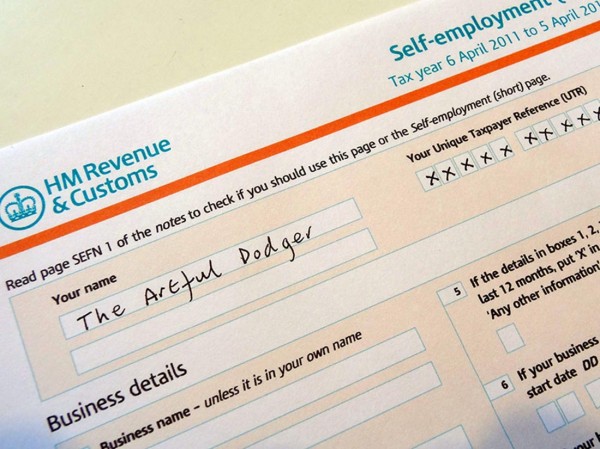 As far as the government is concerned, there is a worry about people moving from employment to self-employment as it tends to reduce tax revenues. Not only will considerably less NIC be paid by previous employers, but the scope for tax evasion is greater in self-employment. There is thus a trade-off between the extra output and small-scale investment that self-employment might bring and the lower NIC/tax revenue for the government.
As far as the government is concerned, there is a worry about people moving from employment to self-employment as it tends to reduce tax revenues. Not only will considerably less NIC be paid by previous employers, but the scope for tax evasion is greater in self-employment. There is thus a trade-off between the extra output and small-scale investment that self-employment might bring and the lower NIC/tax revenue for the government.
Articles
Thriving in the gig economy Philippine Daily Inquirer, Michael Baylosis (10/3/17)
6 charts that show how the ‘gig economy’ has changed Britain – and why it’s not a good thing Business Insider, Ben Moshinsky (21/2/17)
What is the ‘gig’ economy? BBC News, Bill Wilson (10/2/17)
Great Freelance, Contract and Part-Time Jobs for 2017 CareerCast (10/3/17)
We have the laws for a fairer gig economy, we just need to enforce them The Guardian, Stefan Stern (7/2/17)
The gig economy will finally have to give workers the rights they deserve Independent, Ben Chu (12/2/17)
Gig economy chiefs defend business model BBC News (22/2/17)
Spring Budget 2017 tax rise: What’s the fuss about? BBC News, Kevin Peachey (9/3/17)
Self-employed hit by national insurance hike in budget The Guardian, Simon Goodley and Heather Stewart (8/3/17)
What national insurance is – and where it goes The Conversation, Jonquil Lowe (10/3/17)
Britain’s tax raid on gig economy misses the mark Reuters, Carol Ryan (9/3/17)
Economics collides with politics in Philip Hammond’s budget The Economist (9/3/17)
UK government publications
Contract types and employer responsibilities – 5. Freelancers, consultants and contractors GOV.UK
Spring Budget 2017 GOV.UK (8/3/17)
Spring Budget 2017: documents HM Treasury (8/3/17)
National Insurance contributions (NICs) HMRC and HM Treasury (8/3/17)
Questions
- Give some examples of work which is generally or frequently done in the gig economy.
- What are the advantages and disadvantages to individuals from working in the gig economy?
- What are the advantages and disadvantages to firms from using the services of people in the gig economy rather than employing people?
- In the case of employed people, both the employees and the employers have to pay NICs. Would it be fair for both such elements to be paid by self-employed people on their own income?
- Discuss ways in which the government might tax the firms which buy the services of people in the gig economy.
- How does the rise of the gig economy affect the interpretation of unemployment statistics?
- What factors could cause a substantial growth in the gig economy over the coming years?
 Economists were generally in favour of the UK remaining in the EU and highly critical of the policy proposals of Donald Trump. And yet the UK voted to leave the EU and Donald Trump was elected.
Economists were generally in favour of the UK remaining in the EU and highly critical of the policy proposals of Donald Trump. And yet the UK voted to leave the EU and Donald Trump was elected.
People rejected the advice of most economists. Many blamed the failure of most economists to predict the 2007/8 financial crisis and to find solutions to the growing gulf between rich and poor, with the majority stuck on low incomes.
So to what extent are economists to blame for the rise in populism – a wave that could lead to electoral upsets in various European countries? The podcast below brings together economists and politicians from across the political spectrum. It is over an hour long and provides an in-depth discussion of many of the issues and the extent to which economists can provide answers.
Podcast
 Should economists share the blame for populism? Guardian Politics Weekly podcast, Heather Stewart, joined by Andrew Lilico, Ann Pettifor, Jonathan Portes, Rachel Reeves and Vince Cable (23/2/17)
Should economists share the blame for populism? Guardian Politics Weekly podcast, Heather Stewart, joined by Andrew Lilico, Ann Pettifor, Jonathan Portes, Rachel Reeves and Vince Cable (23/2/17)
Questions
- Why has globalisation become a dirty word?
- Assess the arguments for and against an open policy towards immigration?
- In what positive ways may economists contribute to populism?
- Do economists concentrate too much on growth in GDP rather than on its distribution?
- Give some examples of ways in which various popular interpretations of economic phenomena may confuse correlation with causality.
- Why did the proportions of people who voted for and against Brexit differ considerably from one part of the country to another, from one age group to another and from one social group to another?
- In what ways have economists and the subject of economics contributed towards a growth in human welfare?
- What are the advantages and disadvantages of the trend for undergraduate economics curricula to become more mathematical (at least until relatively recently)?
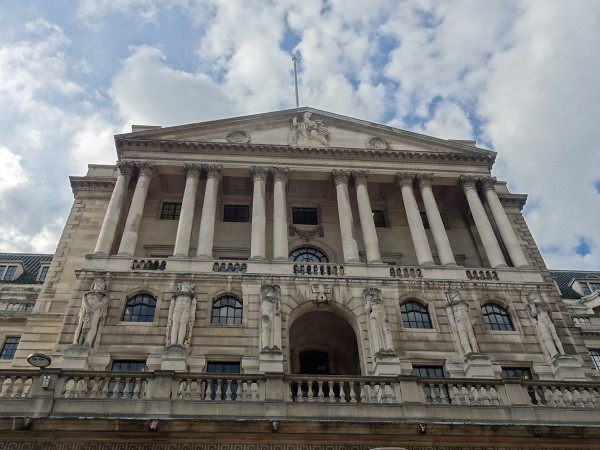 When UK unemployment was 7.7% in July 2013, Mark Carney, the newly arrived governor of the Bank of England, said that the Bank would probably have to rise interest rates when the unemployment rate dropped below 7%. Below that rate, it was expected that inflation would rise. In other words, 7% was the NAIRU – the non-accelerating rate of inflation. The most recent figure for the unemployment rate is 4.8% and yet the Bank of England has not raised interest rates. In fact, in response to the Brexit vote, it cut Bank Rate from 0.5% to 0.25% in August last year. (Click here for a PowerPoint of the chart below.)
When UK unemployment was 7.7% in July 2013, Mark Carney, the newly arrived governor of the Bank of England, said that the Bank would probably have to rise interest rates when the unemployment rate dropped below 7%. Below that rate, it was expected that inflation would rise. In other words, 7% was the NAIRU – the non-accelerating rate of inflation. The most recent figure for the unemployment rate is 4.8% and yet the Bank of England has not raised interest rates. In fact, in response to the Brexit vote, it cut Bank Rate from 0.5% to 0.25% in August last year. (Click here for a PowerPoint of the chart below.)
The NAIRU is a similar, although not identical, concept to the natural rate of unemployment. The natural rate is the equilibrium rate consistent with an overall long-term balance of aggregate labour demand and supply: i.e. the rate after short-term cyclical movements in unemployment have been discounted. It is thus a long-term concept.
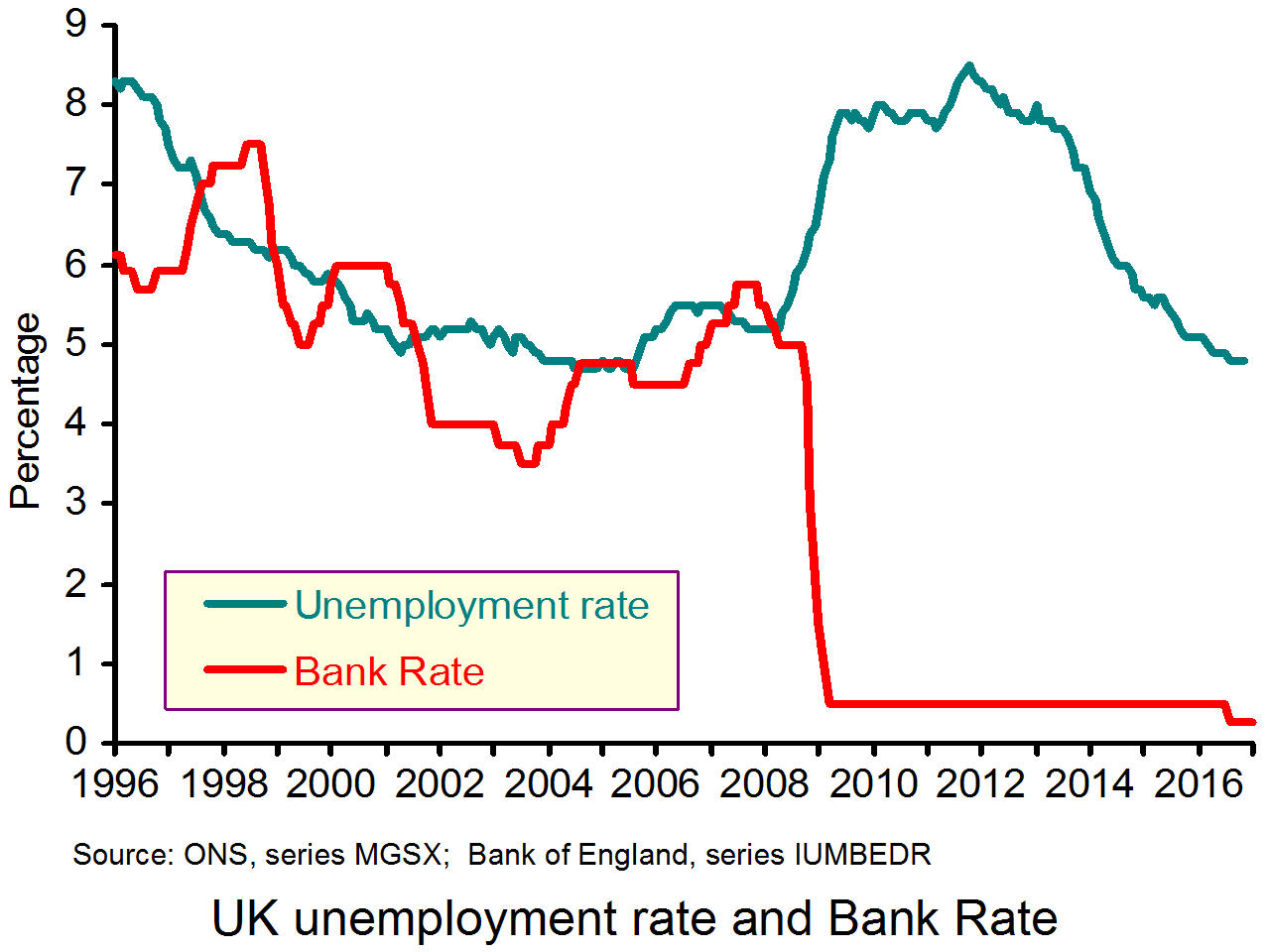 The NAIRU, although similar, focuses on the relationship between inflation and unemployment. With inflation caused solely by demand-side factors, the natural rate and the NAIRU will be similar if not identical. However, if cost-push factors change – say there is a poor harvest, which pushes up food prices and inflation (temporarily), or a substantial depreciation of the exchange rate caused by political factors (such as Brexit) – the NAIRU would increase, at least in the short term, as a higher rate of unemployment would be necessary to stop inflation rising. In the long term, although being defined differently, the NAIRU and the natural rate will be the same.
The NAIRU, although similar, focuses on the relationship between inflation and unemployment. With inflation caused solely by demand-side factors, the natural rate and the NAIRU will be similar if not identical. However, if cost-push factors change – say there is a poor harvest, which pushes up food prices and inflation (temporarily), or a substantial depreciation of the exchange rate caused by political factors (such as Brexit) – the NAIRU would increase, at least in the short term, as a higher rate of unemployment would be necessary to stop inflation rising. In the long term, although being defined differently, the NAIRU and the natural rate will be the same.
In practice, because the Bank of England is targeting inflation at a 24-month time horizon, the NAIRU for the UK at that point could also be seen as the natural rate.
So with the Bank of England not raising interest rates despite the considerable fall in the unemployment rate, does this imply a fall in the natural rate of unemployment? The answer is yes. The reason has to do with changes in the structure of the labour market.
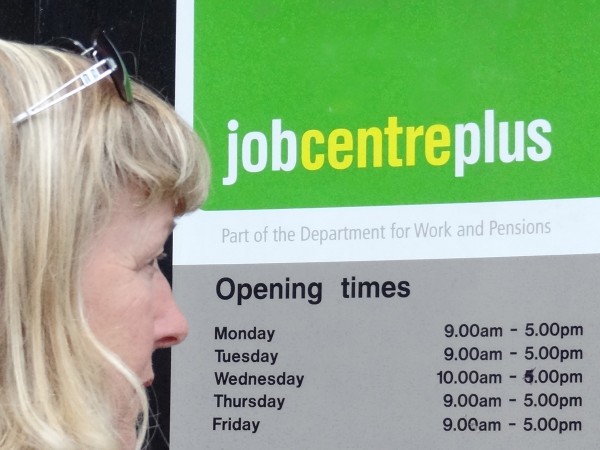 The proportion of young people and women with children returning to the labour market has fallen. Such people have a higher-than-average rate of unemployment since they typically spend a period of time searching for a job.
The proportion of young people and women with children returning to the labour market has fallen. Such people have a higher-than-average rate of unemployment since they typically spend a period of time searching for a job.
Tax and benefit reforms over the years have increased the incentive for the unemployed to take work.
Perhaps the biggest factor is a greater flexibility in the labour market. As union power has waned and as people are increasingly working on flexible contracts, including zero-hour contracts, so this has moderated wage increases. At the same time, many firms are facing increased competition both from abroad and domestically via the Internet. This has put downward pressure on prices and hence on the wages firms are willing to pay.
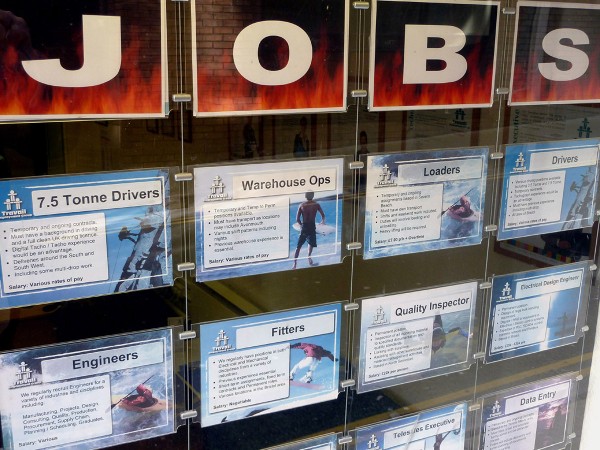 The effect has been a fall in the NAIRU and probably the natural rate. Frictions in the labour market have reduced and people losing their jobs because of changes in industrial structure find it easier to get jobs in low-skilled service industries, where employers’ risks of taking on such workers have fallen because of the loss of rights for such workers.
The effect has been a fall in the NAIRU and probably the natural rate. Frictions in the labour market have reduced and people losing their jobs because of changes in industrial structure find it easier to get jobs in low-skilled service industries, where employers’ risks of taking on such workers have fallen because of the loss of rights for such workers.
So what is the natural rate of unemployment today? It is certainly much lower than 7%; the consensus is that it is probably below 5%. As Kristin Forbes, External MPC Member of the Bank of England stated in a recent speech:
[Unemployment] is forecast to increase gradually from its current 4.8% to a high of 5.0% in the second half of 2017, before falling back to its current rate by the end of 2019. To put this in context, 5.0% was previously believed to be around the UK’s natural rate of unemployment – the rate below which unemployment could not fall without wages picking up to levels inconsistent with sustaining inflation around the 2% target. Unemployment at 5.0% is also below the average unemployment rate for the UK over the pre-crisis period from 1997 to 2007 (when it was 5.5%).
She went on to discuss just what the figure is for the natural, or ‘equilibrium’, rate of unemployment (U*). One problem here is that there is considerable uncertainty over the figure in the current forecast made by the Bank.
[An] assumption in the forecast about which there is substantial uncertainty is of the equilibrium unemployment rate – or U* for short. Since I have been on the MPC, the Committee has assumed that U* was around 5%. This implied that the more by which unemployment exceeded 5%, the more slack existed in the economy, and the less upward momentum would be expected in wages (controlling for other factors, such as productivity growth).
 As part of our annual assessment of regular supply-side conditions this January, Bank staff presented several pieces of analysis that suggested U* may be lower than 5% today [see, for example]. The majority of the MPC voted to lower our estimate of U* to 4.5%, based partly on the persistent weakness of wage growth over the past few years after accounting for other factors in our models. [See page 20 of the February 2017 Inflation Report.]
As part of our annual assessment of regular supply-side conditions this January, Bank staff presented several pieces of analysis that suggested U* may be lower than 5% today [see, for example]. The majority of the MPC voted to lower our estimate of U* to 4.5%, based partly on the persistent weakness of wage growth over the past few years after accounting for other factors in our models. [See page 20 of the February 2017 Inflation Report.]
My own assessment, however, suggested that although U* was likely lower than 5% today, it is likely not as low as 4.5%. If true, this would suggest that there is less slack in the economy than in the MPC’s central forecast, and wage growth and inflation could pick up faster than expected.
Against that, however, uncertainty related to Brexit negotiations could make firms more cautious about raising wages, thereby dampening wage growth no matter where unemployment is relative to its equilibrium. Moreover, even if we could accurately measure the level of U* in the economy today, it could easily change over the next few years as the labour force adjusts to any changes in the movement of labour between the UK and European Union.
Determining the precise figure of the current natural rate of unemployment, and predicting it for the medium term, is very difficult. It involves separating out demand-side factors, which are heavily dependent on expectations. It also involves understanding the wage elasticity of labour supply in various markets and how this has been affected by the increased flexibility of these markets.
Articles
When will Britons get a pay rise? The Guardian, Phillip Inman (26/2/17)
BoE decision, Inflation Report – Analysts react DigitalLook, Alexander Bueso (2/2/17)
Bank of England hikes UK economic growth forecasts but warns of rising inflation The Telegraph, Szu Ping Chan (2/2/17)
Bank of England publications
Inflation Report Bank of England (February 2017)
A MONIAC (not manic) economy Bank of England Speeches, Kristin Forbes (8/2/17)
The labour market Bank of England Speeches, Michael Saunders (31/1/17)
Questions
- Distinguish between the following terms: natural rate of unemployment, NAIRU, equilibrium rate of unemployment, disequilibrium rate of unemployment.
- For what reasons did the Monetary Policy Committee members feel that the equilibrium rate of unemployment might be as low as 4.25%?
- Why might it be as high as 5%?
- How are changes in migration trends likely to affect (a) wage growth and (b) unemployment?
- How is the amount of slack in an economy measured? What impact does the degree of slack have on wage growth and inflation?
- What is meant by the ‘gig’ economy? How has the development of the gig economy impacted on unemployment and wages?
- Why has there been a considerable rise in self employment?
- How may questions of life style choice and control over the hours people wish to work impact on the labour market?
- If people are moving jobs less frequently, does this imply that the labour market is becoming less flexible?
- Why may firms in the current climate be cautious about raising wages even if aggregate demand picks up?
 Cloud computing is growing rapidly and has started to dominate many parts of the IT market. Cloud revenues are rising at around 25% per year and, according to Jeremy Duke of Synergy Research Group:
Cloud computing is growing rapidly and has started to dominate many parts of the IT market. Cloud revenues are rising at around 25% per year and, according to Jeremy Duke of Synergy Research Group:
“Major barriers to cloud adoption are now almost a thing of the past, especially on the public-cloud side. Cloud technologies are now generating massive revenues for technology vendors and cloud service providers, and yet there are still many years of strong growth ahead.”
The market leader in cloud services (as opposed to cloud hardware) is Amazon Web Services (AWS), a subsidiary of Amazon. At the end of 2016, it had a market share of around 40%, larger than the next three competitors (Microsoft, Google and IBM), combined. AWS originated cloud computing some 10 years ago. It is set to have generated revenue of $13 billion in 2016.
The cloud computing services market is an oligopoly, with a significant market leader, AWS. But is the competition from other players in the market, including IT giants, such as Google, Microsoft, IBM and Oracle, enough to guarantee that the market stays competitive and that prices will fall as technology improves and costs fall?
Certainly all the major players are investing heavily in new services, better infrastructure and marketing. And they are already established suppliers in other sectors of the IT market. Microsoft and Google, in particular, are strong contenders to AWS. Nevertheless, as the first article states:
Neither Google nor Microsoft have an easy task since AWS will continue to be an innovation machine with a widely recognized brand among the all-important developer community. Both Amazon’s major competitors have an opportunity to solidify themselves as strong alternatives in what is turning into a public cloud oligopoly.
Articles
While Amazon dominates cloud infrastructure, an oligopoly is emerging. Which will buyers bet on? diginomica, Kurt Marko (16/2/17)
Study: AWS has 45% share of public cloud infrastructure market — more than Microsoft, Google, IBM combined GeekWire, Dan Richman (31/10/16)
Cloud computing revenues jumped 25% in 2016, with strong growth ahead, researcher says GeekWire, Dan Richman (4/1/17)
Data
Press releases Synergy Research Group
Questions
- Distinguish the different segments of the cloud computing market.
- What competitive advantages does AWS have over its major rivals?
- What specific advantages does Microsoft have in the cloud computing market?
- Is the amount of competition in the cloud computing market enough to prevent the firms from charging excessive prices to their customers? How might you assess what is ‘excessive’?
- What barriers to entry are there in the cloud computing market? Should they be a worry for competition authorities?
- Are the any network economies in cloud computing? What might they be?
- Cloud computing is a rapidly developing industry (for example, the relatively recent development of cloud containers). How does the speed of development impact on competition?
- How would market saturation affect competition and the behaviour of the major players?
 In the blog OPEC deal pushes up oil prices John discussed the agreement made by OPEC members to reduce total oil output from the start of 2017, with Saudi Arabia making the biggest cut in output. The amount of oil being provided is a key determinant of the oil price and this agreement to reduce oil output contributed to rising prices. However, now oil prices have begun to fall (see chart below) with Saudi Arabia in particular recording an increase in output but all OPEC nations noting that global crude stocks had risen.
In the blog OPEC deal pushes up oil prices John discussed the agreement made by OPEC members to reduce total oil output from the start of 2017, with Saudi Arabia making the biggest cut in output. The amount of oil being provided is a key determinant of the oil price and this agreement to reduce oil output contributed to rising prices. However, now oil prices have begun to fall (see chart below) with Saudi Arabia in particular recording an increase in output but all OPEC nations noting that global crude stocks had risen. This was one of the main factors that contributed to the oil price lows that we previously saw. OPEC’s forecast for oil production from non-OPEC member has been raised for 2017 and overall production from all oil producing nations looks set to increase for the year, despite OPEC curbing output by 1.2 million barrels per day. However, despite the 10% drop, the price of crude oil ($50) still remains well above its low of $28 in January 2016.
This was one of the main factors that contributed to the oil price lows that we previously saw. OPEC’s forecast for oil production from non-OPEC member has been raised for 2017 and overall production from all oil producing nations looks set to increase for the year, despite OPEC curbing output by 1.2 million barrels per day. However, despite the 10% drop, the price of crude oil ($50) still remains well above its low of $28 in January 2016.














